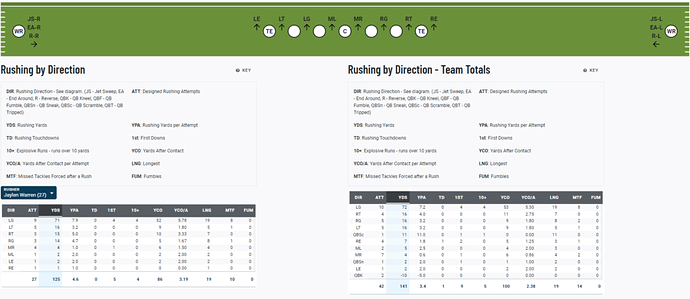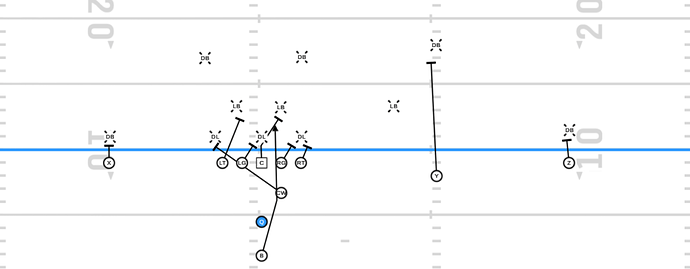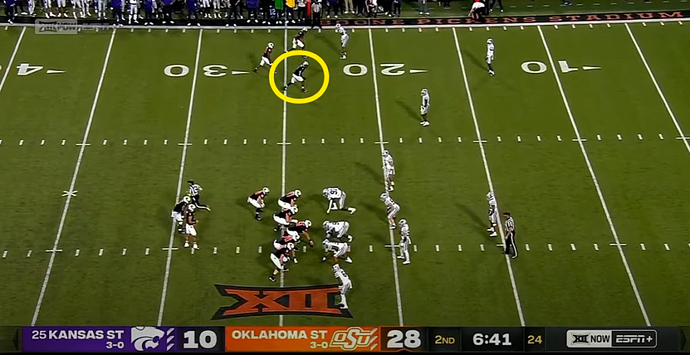In Part 1, we took a look at Oklahoma State's overall offensive scheme from their 31-20 victory in the 2021 conference opener against Kansas State. For today's post, I'm going to go into further detail on the Cowboy running game, covering what worked and what didn't work against the the Wildcats. Before I get into the film, I wanted to start things off by taking a look at several different groupings of statistics.
First, I have the breakdown of rushing attempts and yards by everyone who carried the ball on Saturday. Just to note, I am excluding the two kneels as the end of the game. Also, I'm removing the one sack, as this was actually a passing play:
- Jaylen Warren: 27 attempts / 123 yards / 4.6 average / 0 TDs / 0 Fumble Lost
- Spencer Sanders: 8 attempts / 20 yards / 2.5 average / 1 TDs / 0 Fumbles Lost
- Dominic Richardson: 5 attempts / 6 yards / 1.2 average / 0 TDs / 0 Fumbles Lost
And, here is the breakdown by play type:
- Zone (Inside, Outside, Read, Split): 36 attempts / 130 yards / 3.6 average / 1 TD / 0 Fumbles Lost
- QB Runs Besides Zone/Power (Draw, Scramble, Sneak): 3 attempts / 14 yards / 4.7 average / 0 TDs / 0 Fumbles Lost
- Power: 1 attempt / 5 yards / 5.0 average / 0 TDs / 0 Fumbles Lost
And for the final stat breakdown, let's take a look by personnel grouping:
- 11 personnel: 30 attempts / 122 yards / 4.1 average / 0 TDs / 0 Fumbles Lost
- 12 personnel: 8 attempts / 24 yards / 3.0 average / 1 TD / 0 Fumbles Lost
- 10 personnel: 2 attempts / 3 yards / 1.5 average / 0 TDs / 0 Fumbles Lost
Similar to last week, I wanted to highlight the Split Zone again. The Pokes ran some variation of this play 21 times for 103 yards (4.9 yards per attempt) and one touchdown. I'll touch on this concept more in the film review below.
PFF Advanced Stats
Before we dive into the film, I wanted to show the PFF Rushing Direction statistics for Warren and the team totals, along with the Run Blocking Grades.
Split Zone
Split Zone is a variation of the zone blocking scheme where the extra blocker, the Cowboy back in OSU’s scheme, blocks across the formation, against the flow of the play. This play causes confusion for the defense, as the Cowboy back is blocking one way but the play is going another way, and it can also create a cut back lane for the ball carrier.
The first play we are going to discuss is Split Outside Zone. In the past we've seen the Pokes run Split Zone with both and Inside and Outside Zone blocking scheme, but against KSU, Warren found a lot of success with his cutbacks when the O-line was blocking Outside Zone. With K-State lining up in a three-down front, it's tough to run inside, as they have solid defensive linemen that can clog up the middle. So, OSU wanted to try and find ways to create misdirection, get the defense to vacate the box and open up a cutback lane for their back. The Cowboys do just that in the play shown below.
The flow of the offensive linemen to the field, or wide side, gets the Wildcat defense moving that way. This, along with great cut blocks by both left tackle Cole Birmingham and Cowboy back Braden Cassity open up a huge cutback lane for Warren. Then, Warren really only has to make one KSU defensive back miss on his way to a 19-yard gain.
The Cowboys’ four longest runs of the day were off of Split Zone, and they got some really solid blocking from both the offensive line and the Cowboy backs on most of these runs. Here’s another example in the following clip.
Creating Misdirection With Formations and Motion
I talked about this in Part 1, but OSU offensive coordinator Kasey Dunn did a great job of utilizing backfield motion and unbalanced formations to create space for the running game. For instance, in the image below, you'll see the circled receiver is actually ineligible as he's on the line of scrimmage.
On this Split Zone play, the right tackle Jack Springfield releases off the line to block the K-State defensive back, and on the other side we see great cut blocks again from Birmingham and Cassity, allowing another huge cutback lane for Warren. This was was setup by Dunn utilizing this formation wrinkle to the field, working in some pre-snap movement in the backfield and having the O-line flow toward the boundary. OSU was able to gain an advantage by using this misdirection.
The next play I wanted to show in the section is Sanders touchdown run. Oklahoma State comes out in 12 personnel, with one Cowboy back in a tight end spot on the line of scrimmage to the field, and one at H-back to the boundary. Before the snap, Sanders shifts Warren from a Pistol set up behind him to this right. The Pokes then go with their Split Zone Bluff play.
In this concept, the H-back will bluff his typical Split Zone block we saw above. By “bluff,” I mean he will go around the backside defensive end and take the first defender on the outside. It works out for OSU and Sanders is able to get in the endzone for six.
Conclusion
As I stated in Part 1, I really liked what Dunn did with the running game last Saturday, especially in the first half. He stuck to the Zone scheme, but mixed in some different formations and motions that we haven't seen yet this season to catch K-State off guard. He's got to find a way to generate more points in the second half, but over the past two games I think Dunn's been pretty solid in regards to his game plan and play calling.
The offensive line had a nice performance in terms of run blocking, specifically Hunter Woodard, Danny Godlevske and Josh Sills. Additionally, Birmingham also had an above average outing, however, I think there is still some room for improvement from Springfield.
The receiving corps had some good initial blocks on the perimeter, but they have got to be more consistent and need to stick with their blocks until the whistle blows. This could be the difference in a nice gain and a long touchdown, depending on how well these guys can block on the outside. Rashod Owens and Tay Martin were probably the best of the bunch, but the rest of this young receiver group will need to get better in this aspect as the season progresses. With how athletic and talented they are though, I don't think this should be an issue.
I've touched on it already above and in Part 1, but Warren's ability to make people miss in space and gain yards after contact is pretty amazing. He runs hard every play, and he's constantly turning would be short gains into nice runs. It would be nice to get Dezmon Jackson and LD Brown back from injury to add in a change of pace for Warren and to see more consistent output from Richardson, but Warren has shown he can handle the heavy load of carries.
Sanders wasn't as much of a factor in the rushing game against KSU as he was in Boise, but he still had a couple of nice plays. I still think he can continue to improve his vision on some runs, do a better job of avoiding big hits and I would love to see him keep the ball more on the read plays, but overall I thought he was fine.
In Part 3, I'll take a look at OSU's aerial attack.



